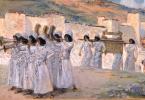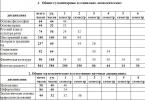KUZNETSOV Vasily Ivanovich, (01/15/1894, Ust-Usolka village, now Usolka village, Cherdynsky district, Perm region - 6/20/1964, Moscow). Russian. Colonel General (1943). Hero of the Soviet Union (29.5.1945).
Served in the Russian army from April 1915 to December 1917, second lieutenant. During the First World War, from April 1915, he served as a private and non-commissioned officer of the 236th reserve regiment in Saransk, then from October - cadet of the Kazan warrant officer school, from March
1916 - ensign of the 120th reserve regiment in Yekaterinburg. In June 1916 he was sent to the active army, as part of the 305th Infantry Regiment he fought on the South-Western Front, the head of a team of foot reconnaissance officers.
In the Red Army since August 1918. Graduated from the ensign school (1916), rifle and tactical advanced training courses for the command staff of the Red Army "Vystrel" named after. Comintern (1926), KUKS (1929), special faculty of the Military Academy. M. V. Frunze (1936).
During the Civil War, V.I. Kuznetsov, commander of a company, battalion and rifle regiment, participated in battles on the Eastern and Southern fronts against the troops of Admiral A.V. Kolchak and General P.N. Wrangel.
During the interwar period, V.I. Kuznetsov served in the UVO from October 1923, commanded the 89th Chongar Rifle Regiment, from January 1931, assistant commander of the 51st Perekop Rifle Division, from December 1930 to March 1931 .i.d. commander of this division. Since March 1931, assistant commander of the 25th Infantry Division. In November 1931, he was appointed commander of the 2nd Turkestan Rifle Division, from October 1936, commander and military commissar of the 99th Rifle Division, from August 1937, commander of the 16th Rifle Corps, then commander of the Vitebsk Army Group of Forces. Since September 1939, V.I. Kuznetsov has been the commander of the 3rd Army of the Zapovo Military District.
With the beginning of the Great Patriotic War, the 3rd Army of the Western Front under the command of V.I. Kuznetsov fought heavy battles with superior enemy forces in a border defensive battle. Since August 1941, V.I. Kuznetsov was the commander of the 21st Army of the Bryansk Front (since September 1, the Southwestern Front), whose troops fought defensive battles in the area. Konotop, Chernigov and Kyiv. In October-November 1941, commander of the HVO troops. Since November 2, simultaneously commander of the 58th Reserve Army of the Supreme High Command Headquarters. Since November 23, V.I. Kuznetsov was the commander of the 1st Shock Army, which was concentrated in the area of Dmitrov, Ignatovo, Zagorsk. Its advanced units, advanced to the Yakhroma area, defeated the advanced detachment of the enemy's 7th Tank Division, which crossed to the eastern bank of the Moscow-Volga canal. In early December, the army under the command of V.I. Kuznetsov as part of the Western Front, in cooperation with the 20th Army, launched a series of counterattacks from the line of Dmitrov, Lobnya to Solnechnogorsk, which made it possible to stop the advance of fascist German troops towards Moscow from the north and northwest. With the transition of Soviet troops to a counteroffensive near Moscow, the army under the command of V.I. Kuznetsov took part in the Klin-Solnechnogorsk and Rzhev-Vyazemsk offensive operations. In mid-January 1942, it was transferred to the reserve of the Supreme High Command Headquarters, regrouped in the area southeast of Staraya Russa, on February 2 it was transferred to the North-Western Front and participated in the Demyansk offensive operation. Since June 1942, V.I. Kuznetsov has been the commander of the 63rd Army of the Stalingrad (from September 1942 - Don) Front, whose troops distinguished themselves in fierce defensive battles on the distant and near approaches to Stalingrad. Since November 1942, V.I. Kuznetsov has been deputy commander of the troops of the Southwestern Front, since December 1942, commander of the 1st Guards Army of the same front (from October 1943 - 3rd Ukrainian), whose units liberated Donbass . From December 1943, deputy commander of the 1st Baltic Front, and from March 16, 1945, commander of the 3rd Shock Army, which in March was withdrawn to the reserve of the 1st Belorussian Front, regrouped to the river. Oder (Odra) to the area north of Tsedsn (Tsedynya), where it took over the defense line of the 47th Army. At the beginning of April, after the transfer of the defense zone to the 61st Army, it was regrouped in the Berlin direction. In the Berlin offensive operation, the army advanced as part of the main strike group of the front. During 5 days of intense fighting, its troops broke the enemy's resistance and on April 21, they were among the first to break into the northwestern outskirts of Berlin. On April 28, army units stormed the resistance center in the Maobit prison area and freed about 7 thousand prisoners languishing there. On April 29, soldiers of the 79th Army Rifle Corps crossed the river. Spree and, repelling the enemy's fierce counterattacks, captured the Reichstag and hoisted the Victory Banner over it. For his personal courage and bravery in the operations of the Great Patriotic War, V. I. Kuznetsov was awarded the title of Hero of the Soviet Union.
After the war, V.I. Kuznetsov was commander of the 3rd Shock Army. Since 1948, Chairman of the Society of the Central Committee of DOSAAF. Since 1953, commander of the PriVO troops. Since June 1957, he conducted scientific work at the General Staff. Retired since September 1960.
Awarded 2 Orders of Lenin, 5 Orders of the Red Banner, 2 Orders of Suvorov 1st class, medals, as well as foreign orders.
BiographyKuznetsov Vasily Ivanovich, Soviet military leader, Colonel General (1943). Hero of the Soviet Union (05/29/1945).
Born into a working-class family. After graduating from school, he worked as an accountant in the Solikamsk zemstvo. Called up for military service in April 1915, a private in the 236th reserve regiment. After graduating from the 1st Kazan School of Ensigns in March 1916, he was promoted to ensign and appointed as a junior officer in the 120th reserve regiment in Yekaterinburg. Member of the First World War. In the active army since June 1916, head of the foot reconnaissance team of the 305th Lanishevsky Infantry Regiment. He fought on the Southwestern Front. In December 1917 he was demobilized, second lieutenant.
In the Red Army since August 1918. Participant in the Civil War: commander of a company and battalion as part of the 4th Perm and 1st Ufa Rifle Regiments, since February 1919, assistant commander for the combat unit of the 263rd Verkhneuralsk Rifle Regiment. He fought on the Eastern Front against the troops of Admiral A.V. Kolchak. From February 1920, he commanded the 89th Chongar Infantry Regiment as part of the 30th Infantry Division, and took part in battles on the Southern Front against the troops of General P.N. Wrangel. After graduating in September 1926 from the rifle-tactical advanced training courses for the command staff of the Red Army "Vystrel" named after. Comintern continued to command the 89th Infantry Regiment in the Ukrainian Military District. After graduating from advanced training courses for senior commanders of the Red Army in Moscow in January 1930, he was appointed assistant commander of the 51st Perekop Rifle Division named after the Mossovet, and from March 1931 - in the same position in the 25th Chapaev Rifle Division. From November 1931 - commander of the 2nd Turkestan Rifle Division. After graduating in October 1936 from the Military Academy of the Red Army named after. M.V. Frunze was appointed commander and military commissar of the 99th Infantry Division. From August 1937 he was commander of the 16th Rifle Corps, and from July 1938 he commanded the Vitebsk Army Group of Forces (later reorganized into the 3rd Army). In February 1939, he was awarded the rank of corps commander. In September 1939, commanding the Vitebsk and Polotsk groups of troops of the Belarusian Front, he took part in a campaign in Western Belarus. In June 1940, he was awarded the rank of lieutenant general.
At the beginning of the Great Patriotic War, the 3rd Army under the command of Lieutenant General V.I. Kuznetsova, as part of the Western Front, fought heavy battles with superior enemy forces in a border defensive battle in Belarus. Units of the army suffered huge losses, but continuing to lead the battles in the most difficult conditions, a month later Army Commander Kuznetsov brought several thousand Red Army soldiers out of encirclement and fighting to his troops. Since August 1941 - commander of the 21st Army on the Bryansk and Southwestern fronts. The army troops steadfastly held the defense in the area of Sumy, but after the Kyiv disaster the army commander had to withdraw his units from the “cauldron” again. From October 1941, he commanded the troops of the Kharkov Military District and at the same time the emerging 58th Reserve Army of the Supreme High Command Headquarters. Since November, Lieutenant General V.I. Kuznetsov commanded the 1st Shock Army, which participated in the Battle of Moscow as part of the Western Front. During the counter-offensive, the army took part in the Klin-Solnechnogorsk and Rzhev-Vyazemsk offensive operations. In February 1942, the army was transferred to the Northwestern Front, where it distinguished itself in the first Demyansk operation, closing the encirclement ring around the Demyansk enemy group. From July to November 1942, he commanded the 63rd Army on the Stalingrad and Don fronts, holding back the enemy offensive for a long time in the defensive phase.
From November 1942 - Deputy Commander of the South-Western Front, from December - Commander of the 1st Guards Army on the South-Western (from October 1943 - 3rd Ukrainian) Front. Units of the 1st Guards Army under his leadership liberated Donbass, fought in the Izyum-Barvenkovsky operation and in the battle for the Dnieper. In May 1943 V.I. Kuznetsov was awarded the rank of Colonel General. Since December 1943, he has been deputy commander of the 1st Baltic Front. In this position, he participated in the Nevelsko-Gorodok offensive operation, in the winter offensive of 1944 near Vitebsk, in the Belarusian strategic offensive, Baltic strategic and East Prussian operations. After the front completed its tasks and was liquidated, in March 1945 he was appointed to the post of commander of the 3rd Shock Army of the 1st Belorussian Front. In April-May 1945, units of the 3rd Shock Army took an active part in the Berlin operation in the direction of the main attack of the front, the capture of the capital of Hitler's Reich, the storming of the Reichstag building and the hoisting of the Victory Banner over it. May 29, 1945 for personal courage and bravery in the operations of the Great Patriotic War, personal courage and courage to Colonel General V.I. Kuznetsov was awarded the title of Hero of the Soviet Union.
After the war, Colonel General V.I. Kuznetsov continued to command the 3rd Shock Army in the Group of Soviet Occupation Forces in Germany. In 1948 he graduated from the Higher Academic Courses at the Higher Military Academy named after K.E. Voroshilova Since May 1948 - Chairman of the Central Committee of DOSARM (since April 1952 - DOSAAF). In October 1953, he was appointed commander of the Volga Military District. Since June 1957, he worked in the central office of the Ministry of Defense. Retired since September 1960. Deputy of the Supreme Soviet of the USSR of the 2nd and 4th convocations. He was buried at the Novodevichy Cemetery in Moscow.
Awarded: 2 Orders of Lenin, 5 Orders of the Red Banner, Orders of Suvorov 1st and 2nd class, medals, foreign orders.
January 15 (3) – 115 years since birthVasily Ivanovich KUZNETSOV (1894 – 1964),
military leader, colonel general,
Hero of the Soviet Union.
Participated in the battle of Moscow as commander of the 1st Shock Army.
The place of formation of the 1st Shock Army was the front-line city of Zagorsk. It was not by chance that the “shock” army received its name, since it became one of the reserves intended for the offensive in the Northern direction. The 1st Shock Army was formed mainly from Siberians, although it also included residents of the Moscow region, the Volga region, the Urals, and sailors of the Pacific Fleet. Lieutenant General V.I. was appointed commander of the 1st Shock Army. Kuznetsov. On November 28, 1941, a difficult situation was created near Yakhroma. The German command hoped to break through the front line in the Dmitrov area, and then, passing through Zagorsk, connect with the group advancing south of Moscow. The counteroffensive of the 1st Shock Army allowed G.K. Zhukov goes on the offensive along the entire Western Front. The 1st Shock not only defended Zagorsk, but also thwarted the plans of the German command. Yu.S. has been studying the combat path of the 1st Shock Army for a long time. Baikovsky. He created a museum of the 1st Shock Army at school No. 18 (Ferma settlement. Sergiev Posad district).
After the Vyazemsk tragedy, fascist German troops found themselves at the walls of Moscow in November 1941, and mortal danger loomed over the capital. On November 15, 1941, Nazi troops broke through the Mozhaisk defense line and captured Volokolamsk; November 23 – 28 – Klin, Solnechnogorsk, Rogachevo, Yakhroma. A company of German soldiers, dressed in Red Army uniforms, crossed the Moscow Canal across the ice. They entered the Yakhroma bridge from the eastern bank, removed the guards, cleared the bridge and captured the village of Peremilovo.
After this, the advanced units of the 7th Panzer Division of the 3rd Panzer Group launched an attack on Dmitrov, Zagorsk, Noginsk with the goal of connecting with Guderian’s 2nd Panzer Army and completing the encirclement of Moscow. The commander of the 1st Shock Army, V.I. Kuznetsov, reported to the General Staff about the current situation. A few minutes later, Stalin called the commander: “The entry of fascist German troops onto the eastern bank of the Moscow Canal creates a serious danger for Moscow! Stop the enemy at any cost, defeat them and throw them back over the canal, and then blow up the Yakhroma bridge. Personally lead the attack!”
The 1st Shock Army - the reserve of the Supreme Command Headquarters - launched a powerful counterattack, stopped the enemy, defeated it and threw it back across the canal.
Vidnaya, E.V. Residents of Zagorsk during the Great Patriotic War. / E.V. Vidnaya – Sergiev Posad “Your interest”. –1996. – 74 s.
Baikovsky, Yu.S. First strike: to the 40th anniversary of the Battle of Moscow / Yu.S. Baikovsky // Forward. – 1981. – December 12. – P. 2 − 3.
I have practically no information about Leonid Sergeevich. I am only convinced that he suffered a difficult fate. This is evidenced by the fact that having received an appointment to the 403rd rp back in 1980 and receiving the next military rank of “lieutenant colonel” in 1983, he only became a colonel in November 1994. At the end of the page there is a letter from N.S. Sivolob with a request to his colleagues to tell about the fate of L.N. Kuznetsov. I join this request... [Ed.]
By Order of the Minister of Defense of the Russian Federation No. 01932 dated November 6, 1994 Lieutenant Colonel L.S. Kuznetsov appointed commander of the 403rd Missile Regiment. At the same time, Lieutenant Colonel Kuznetsov was awarded the next military rank - colonel. Colonel Kuznetsov became the successor in this post of Pchelintsev Yu.A., transferred to the Teikovsky division.
According to some reports, after the disbandment of the 403rd Missile Regiment, the surrender of weapons and equipment, Colonel L.S. Kuznetsov. appointed commander of the 839th missile regiment (Teykovo), where he served until 1998...
 P/p-ki Pchelintsev Yu.A. and Kuznetsov L.S. (autumn 1994) |
||
 |
 |
|
 |
 |
|
| Lieutenant Colonel Kuznetsov L.S., (November 1994) | ||
“After watching a film about military unit 44121, about the beginning of the withdrawal phase of the regiment from Belarus, and the issuance of the order to march by regiment commander Kuznetsov, I couldn’t help but think about it.
Kuznetsov and 403 rp.
From the regular category of the regiment, Lieutenant Colonel Kuznetsov is the oldest in terms of length of stay in the regiment. Namely, fifteen years. Moreover, 15 difficult years for both the regiment and Kuznetsov: the last years of duty on the R-12, removal from duty, two rearmaments, redeployment of the regiment and disbandment. No one can compare with him for such workload and responsibility. For the first time I met Leonid Sergeevich, commander of the 6th starting battery, in December 1975 at a comprehensive battery training in military unit 23458 (Ostrovsky Regiment). Confidently commanding the battery, he stood out among other battalion commanders.
In August 1980, after an emergency in the second division of 403 rp and the removal of the former division commander from his position, L.S. Kuznetsov arrived as commander of the 2nd division. The second division, distant from the regiment, is more independent; involuntarily it receives less attention from the headquarters and command of the regiment. Kuznetsov's predecessor in this position, possessing remarkable human qualities, did not impose sufficient command demands primarily on his assistants and the division officers. Kuznetsov had to find such methods of work so as not to turn the officers against himself from the first steps. It was not for nothing that I singled out a stage in the life of the regiment: the last years of duty at 8K63. The equipment was obsolete, missile weapons were maintained in combat-ready condition, and overhauls were carried out. repairs, regulations. The supply of spare parts for vehicles was zero (the divisions contributed to the ZPR divisions by pooling money). Officer staffing was even worse. There were only a few graduates from military universities. The main intake of officers are two-year officers. Even though they were well trained in their specialty, as educators for l/s, they were not always at their best. Officers who graduated from secondary military schools in the early 60s, by the end of the 70s, lost perspective and interest in service, and some fell into drunkenness. This was the period when the rearmament of other regiments of the 50th RA began. Officers who could not find a place on the new equipment were sent to complete the P-12 regiments, incl. in Ruzhany. These officers arrived without families (especially from the Baltic republics) and settled in division hotels. Their mood for service was not the best. It was in this situation that Kuznetsov had to begin his service as a division commander. Combining high demands with concern for personnel, he managed to unite the division’s staff and, even in these difficult conditions, successfully solve the problems of maintaining combat readiness and performing combat duty. He lived for the service; he did not need to be reminded of his arrival at the service on Saturday, and often on Sunday.
In the 70-80s, political officers had a rule: the assignment of the next military rank on the same day, that is, on the day the previous rank was assigned, the officer was assigned the next military rank (in the absence of outstanding penalties). Commanding officers always had delays. Leaving the regiment at the end of July 1983, I was glad that I was able to complete all the documents so that Kuznetsov would receive another promotion to lieutenant colonel on the same day.
Kuznetsov Vasily Ivanovich
03.01.1894 - 20.06.1964
Hero of the Soviet Union
Born into a working-class family. After graduating from school, he worked as an accountant in the Solikamsk zemstvo. Called up for military service in April 1915, a private in the 236th reserve regiment. After graduating from the 1st Kazan School of Ensigns in March 1916, he was promoted to ensign and appointed as a junior officer in the 120th reserve regiment in Yekaterinburg. Member of the First World War. In the active army since June 1916, head of the foot reconnaissance team of the 305th Lanishevsky Infantry Regiment. He fought on the Southwestern Front. In December 1917 he was demobilized, second lieutenant.
In the Red Army since August 1918. Participant in the Civil War: commander of a company and battalion as part of the 4th Perm and 1st Ufa Rifle Regiments, since February 1919, assistant commander for the combat unit of the 263rd Verkhneuralsk Rifle Regiment.
At the beginning of the Great Patriotic War, the 3rd Army under the command of Lieutenant General V.I. Kuznetsov, as part of the Western Front, fought heavy battles with superior enemy forces in a border defensive battle in Belarus. Units of the army suffered huge losses, but continuing to lead the battles in the most difficult conditions, a month later Army Commander Kuznetsov brought several thousand Red Army soldiers out of encirclement and fighting to his troops. Since August 1941 - commander of the 21st Army on the Bryansk and Southwestern fronts. The army troops steadfastly held the defense in the area of Sumy, but after the Kyiv disaster the army commander had to withdraw his units from the “cauldron” again. From October 1941, he commanded the troops of the Kharkov Military District and at the same time the emerging 58th Reserve Army of the Supreme High Command Headquarters. Since November, Lieutenant General V.I. Kuznetsov commanded the 1st Shock Army, which participated in the Battle of Moscow as part of the Western Front. During the counter-offensive near Moscow, the army took part in the Klin-Solnechnogorsk and Rzhev-Vyazemsk offensive operations. In February 1942, the army was transferred to the Northwestern Front, where it distinguished itself in the first Demyansk operation, closing the encirclement ring around the Demyansk enemy group. From July to November 1942, he commanded the 63rd Army on the Stalingrad and Don fronts, holding back the enemy advance for a long time in the defensive phase of the Battle of Stalingrad.
From November 1942 - Deputy Commander of the South-Western Front, from December - Commander of the 1st Guards Army on the South-Western (from October 1943 - 3rd Ukrainian) Front. Units of the 1st Guards Army under his leadership liberated Donbass, fought in the Izyum-Barvenkovsky operation and in the battle for the Dnieper. In May 1943, V.I. Kuznetsov was awarded the rank of Colonel General. Since December 1943, he has been deputy commander of the 1st Baltic Front. In this position, he participated in the Nevelsko-Gorodok offensive operation, in the winter offensive of 1944 near Vitebsk, in the Belarusian strategic offensive, Baltic strategic and East Prussian operations. After the front completed its tasks and was liquidated, in March 1945 he was appointed to the post of commander of the 3rd Shock Army of the 1st Belorussian Front. In April-May 1945, units of the 3rd Shock Army took an active part in the Berlin operation in the direction of the main attack of the front, the capture of the capital of Hitler's Reich, the storming of the Reichstag building and the hoisting of the Victory Banner over it. May 29, 1945 for personal courage and bravery in the operations of the Great Patriotic War, personal courage and courage to Colonel General V.I. Kuznetsov was awarded the title of Hero of the Soviet Union.
Awarded: 2 Orders of Lenin, 5 Orders of the Red Banner, Orders of Suvorov 1st and 2nd class, medals, foreign orders.




